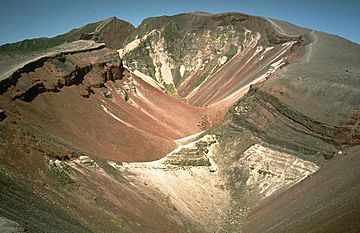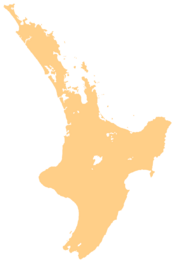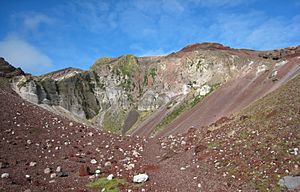Mount Tarawera facts for kids
Quick facts for kids Mount Tarawera |
|
|---|---|

A crack in the mountain from the 1886 eruption
|
|
| Highest point | |
| Elevation | 1,111 m (3,645 ft) |
| Geography | |
| Geology | |
| Mountain type | Lava dome with fissure vent |
| Volcanic arc/belt | Taupo Volcanic Zone |
| Last eruption | May 1981 (Waimangu) June 1951 (Rotomahana) June to August 1886 (Tarawera) |
Mount Tarawera is a famous volcano on the North Island of New Zealand. It's about 24 kilometers southeast of Rotorua. The mountain is made of several lava domes. A huge eruption in 1886 split the mountain down the middle.
This eruption was one of New Zealand's biggest ever and sadly killed around 120 people. The cracks from the eruption stretch for about 17 kilometers. The highest part of the volcano is Ruawahia Dome, which is 1,111 meters tall.
Mount Tarawera is surrounded by several beautiful lakes. Many of these lakes were formed or changed a lot by the 1886 eruption. Some of these lakes include Tarawera, Rotomahana, and Tikitapu (also known as the Blue Lake). The Tarawera River flows from Lake Tarawera, past the northern side of the mountain.
In 2000, the mountain was given back to the Ngati Rangitihi, a local Māori group. A few years later, they and the people renting the land stopped allowing free public access to the mountain. This made many people in Rotorua unhappy.
Contents
Past Eruptions of Mount Tarawera
Mount Tarawera has erupted more than once. One important eruption happened around the year 1315. This event is known as the Kaharoa eruption.
Scientists believe the ash from this eruption might have changed temperatures around the world. It may even have played a part in the Great Famine of 1315–17 in Europe.
The Big 1886 Eruption
The most famous eruption of Mount Tarawera happened on June 10, 1886. Just after midnight, people in the Rotorua area felt more than 30 strong earthquakes. By 2:45 AM, all three peaks of Mount Tarawera had erupted! They blasted huge columns of smoke and ash thousands of meters into the sky.
Around 3:30 AM, the eruption got even bigger. Vents at Rotomahana created a fast-moving cloud of hot gas and ash called a pyroclastic surge. This surge destroyed several villages within 6 kilometers of the volcano. It also seemed to wipe out the famous Pink and White Terraces.
New studies show that what eyewitnesses described was like a giant pot boiling over. Many Māori villages were buried or destroyed. These included Moura, Te Wairoa, and others around Lake Tarawera.
The eruption officially killed 153 people. Many more lost their homes and became refugees in their own country for many years. This makes it the deadliest eruption in New Zealand's history.
One of the buried villages, Te Wairoa, is now a tourist attraction called "the buried village of Te Wairoa". For a long time, people thought the beautiful Pink and White Terraces were completely lost. A small part of the Pink Terraces was reportedly found again under Lake Rotomahana 125 years later.
More recently, old maps from 1859 were studied. These maps show that the Pink, Black, and White Terraces might now be buried along the edges of the lake. This means they might not be completely destroyed after all.
The Legend of the Phantom Canoe
A famous legend about the 1886 eruption is the story of the phantom canoe. Eleven days before the eruption, a group of tourists was returning from the Terraces by boat. They saw what looked like a war canoe coming towards them. But then, it disappeared into the mist about half a mile away.
One of the people who saw it was a local Māori clergyman from the Te Arawa tribe. No one around the lake owned such a war canoe. Nothing like it had been seen on the lake for many years.
Some people think that changes in the lake level before the eruption might have freed a buried waka (canoe) from its resting place. Traditionally, dead chiefs were sometimes tied in an upright position in their canoes. Letters from the tourists who saw this event have been published.
Even though some people thought it was just a strange reflection in the mist, tribal elders at Te Wairoa believed it was a waka wairua (spirit canoe). They saw it as a sign that something bad was going to happen. Some have suggested the waka was actually a large wave caused by underground shaking. But many locals believe that if the canoe appears again, it will signal another eruption in the future.
Images for kids
See also
 In Spanish: Tarawera para niños
In Spanish: Tarawera para niños










